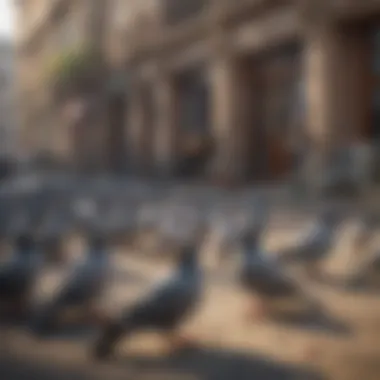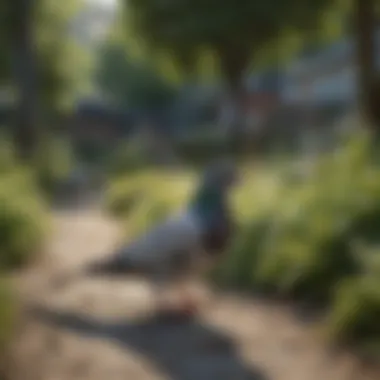Effective Strategies to Keep Pigeons Away


Intro
Pigeon populations in urban and suburban areas often lead to multiple issues. Homeowners face problems like property damage, unsightly droppings, and health concerns associated with pests and diseases. Consequently, effective methods to keep pigeons away become essential for maintaining aesthetic spaces while preserving property value. This article delves deeply into strategies that employers or homeowners can employ to deter these birds humanely and practically.
Design Inspirations
When creating a space that discourages pigeons, design plays a key role. Certain aesthetic choices lend themselves well to keeping these birds at bay, combining beauty with functionality.
Ambient Environments
To begin with, consider landscaping techniques. Simple steps can transform your outdoor area into an environment less appealing to pigeons. Shrubs and thorny plants can serve as natural obstacles, preventing pigeons from resting or nesting on your property. The overall garden structure should integrate plant choices that discourage bird landing, making the area uninviting.
Minimalist Structures
Incorporate sleek, modern designs in outdoor furniture to avoid flat surfaces where pigeons might settle. For instance, opting for round tables and chairs can minimize the areas where these birds potentially perch. This minimalist approach reduces perching points and enhances the outdoor experience for people while keeping pigeons at a distance.
Understanding the Pigeon Problem
Understanding the nature of the pigeon problem is essential for developing effective strategies to keep these birds away from your property. Pigeons, often seen as harmless creatures, can lead to significant challenges when their populations grow unchecked. This section addresses the pivotal elements of pigeon behavior, the reasons for infestation, and the health risks associated with their presence. Recognizing these factors offers valuable insights into the implications of having pigeons around.
Overview of Pigeon Behavior
Pigeons are highly adaptable birds, known for their ability to thrive in urban environments. They often seek areas that offer food sources, water, and shelter. Their social structure also plays a role; pigeons typically congregate in flocks, which can exacerbate infestation problems. The birds have a unique foraging behavior, often seen scavenging for food in public spaces or residential gardens. When food is consistently available, they tend to return, establishing a strong presence.
Understanding this behavior is crucial for homeowners. If one is aware of where pigeons thrive, it becomes easier to address the factors that attract them in the first place.
Reasons for Pigeon Infestation
Pigeon infestations can stem from various factors, most notably the availability of food and suitable nesting sites.
- Food Supply: Pigeons are opportunistic feeders and will consume a variety of food items, including discarded scraps. Common public spaces, parks, and residential areas without effective waste management often attract these birds.
- Nesting Areas: Pigeons look for sheltered spots for nesting. A building's architecture, such as ledges, awnings, and overhangs, can provide ideal locations for nesting, further contributing to the population growth.
- Water Access: Pigeons require water for drinking and bathing. Stagnant water or bird baths in gardens can become a draw for them.
The intersection of these factors creates fertile ground for pigeon colonies, leading to significant problems for property owners if left unchecked.
Health Risks Associated with Pigeons
While pigeons may seem harmless, their presence can pose several health risks. These birds are known carriers of various pathogens, which can be transmitted to humans and other animals.
- Respiratory Diseases: Pigeon droppings can contain fungi that may lead to respiratory illnesses in humans, such as histoplasmosis.
- Parasites: Pigeons may also harbor parasites, including ticks and mites, which can infest surrounding areas and pose risks to domestic pets.
- Fecal Contamination: Pigeon waste is not only a nuisance but is also corrosive and can damage property, leading to costly repairs.
Awareness of these health risks emphasizes the importance of implementing effective strategies against pigeons. Every homeowner must prioritize both their property's integrity and their family's health in any pigeon management approach.
The understanding of pigeon behavior, reasons for infestations, and associated health risks lays the groundwork for effective control strategies.
Preventative Measures
Preventative measures play a crucial role in minimizing pigeon populations in your area. These strategies not only address current issues but also help to prevent future infestations. By understanding and implementing effective measures, homeowners can maintain their spaces without unwanted disruptions. Properly executed preventative steps create an environment less conducive to pigeons, benefitting both the aesthetics and functionality of a property.
Proper Waste Management
Proper waste management is one of the fundamental strategies in controlling pigeon populations. Pigeons are attracted to easily accessible food sources, and improperly disposed waste can provide that. By ensuring garbage is securely sealed in bins and compost piles are well-contained, it reduces the chances of attracting these birds.
Consider the following waste management practices:


- Use sealed trash cans: Make sure all trash cans have tight lids.
- Clean up food spills: Regularly inspect and clean areas where food waste may accumulate.
- Encourage responsible disposal: Inform family or guests about correct waste disposal methods.
Establishing these practices creates a less attractive environment for pigeons and has the added benefit of reducing odors and other pests.
Implementing Non-Attractive Feeds
Implementing non-attractive feeds means controlling what is available in your outdoor environment. Pigeons tend to gather in areas where food is plentiful. Therefore, if you regularly feed pets or birds outside, consider the type of feeds you use. Instead of traditional bird seeds, which may attract pigeons, opting for less appealing alternatives can reduce their numbers.
Additionally, avoid leaving out uneaten food. If you have outdoor dining or barbecues, promptly remove food remnants. This not only keeps pigeons at bay but also prevents attracting other wildlife that may be unwanted.
Sealing Nesting Areas
Sealing nesting areas is another vital aspect of preventing pigeon infestations. Pigeons often seek safe and sheltered spots to nest. Inspect your property for potential nesting sites such as:
- Eaves and ledges: These are common places for pigeons to settle down.
- Chimneys: Ensure they are capped if they are not in use.
- Roofs and attics: Regular checks for openings in roofs can stop pigeons from finding entry points.
Once identified, these areas should be sealed or modified. Using physical barriers like netting or spikes can discourage them from nesting. Such efforts not only help in managing current populations but also prevent future challenges.
Proper implementation of these preventative measures assures a lower likelihood of pigeons returning, thereby maintaining a cleaner and more pleasant environment.
Physical Deterrents
Physical deterrents play an important role in managing pigeon populations effectively. These strategies work by creating an environment that is less hospitable for pigeons, thus discouraging them from nesting or roosting in certain areas. Physical methods are often preferred because they can be both humane and effective, providing a long-term solution without harming the birds. Implementing these measures can significantly reduce pigeon presence and protect property from damage that results from these birds.
Installing Bird Spikes
Bird spikes are one of the most common physical deterrents used to keep pigeons away. They are long, thin pieces of plastic or metal that are installed along ledges, rooftops, and other surfaces where pigeons might roost. The primary purpose of these spikes is to make it uncomfortable for pigeons to land.
The installation of bird spikes is a straightforward process and can often be done without professional assistance. However, it is essential to position them correctly. Placing spikes too far apart may allow birds to squeeze through, while placing them too close could lead to overlap and ineffective deterrence. The smart choice here is to measure the area and ensure complete coverage without any gaps.
While bird spikes provide a visible means of deterrent, they do not harm the birds. Instead, they encourage pigeons to seek more accommodating areas, effectively reducing their population in troublesome spots.
Using Bird Nets
Bird nets serve as another effective physical barrier against pigeons. These nets can block access to roofs, balconies, and other structures where pigeons might gather. They are usually made from durable materials that withstand various weather conditions, making them a long-lasting solution.
Before installing bird nets, it is crucial to assess the area. The size of the space determines the type of netting required. When properly installed, bird nets can prevent pigeons from entering designated areas while maintaining the aesthetics of your property.
Furthermore, these nets are versatile. They can be used in gardens, on farms, and in urban settings. Care must be taken to ensure birds do not become trapped in the nets. Proper netting techniques can minimize this risk while ensuring that pigeons are effectively deterred.
Employing Visual Deterrents
Visual deterrents utilize the pigeons’ natural aversion to certain stimuli to keep them at bay. These can include items such as reflective tapes, predator decoys, and even fake owls placed strategically in areas prone to pigeon activity. The idea is to create an environment where pigeons feel threatened by the presence of predators, thus discouraging them from settling down.
When using visual deterrents, placement is key. Hanging reflective tapes from trees or buildings can confuse and scare off pigeons. Similarly, setting up decoys simulating natural predators can be effective if they are altered periodically to maintain their efficacy. Pigeons can become accustomed to stationary threats, so occasional repositioning can keep them from becoming desensitized.
"Physical deterrents offer a balanced approach towards controlling pigeon populations without causing harm to them."
Overall, incorporating a combination of these physical deterrents can yield substantial rewards in keeping pigeons away. By making specific areas less attractive through spikes, nets, and visual stimuli, homeowners can protect their properties while maintaining an ethical stance towards wildlife.
Auditory Deterrents
Auditory deterrents play a significant role in managing pigeon populations. Sound can influence animal behavior, either attracting or repelling species. When it comes to pigeons, certain noises can create an environment that discourages their presence. Understanding the use of sound devices and their limitations is key for effective pigeon control. A strategic approach to sound can not only reduce pigeon activity but also maintain a peaceful atmosphere in residential areas.


Sound Devices for Pigeon Control
Various sound devices are available to help control pigeon populations. Sonic repellents emit sounds that are unpleasant to pigeons, such as predator calls. These devices are designed to mimic natural threats, signaling danger to the pigeons. Some popular examples include:
- Ultrasonic repellers: These emit high-frequency sounds that are inaudible to humans but can disturb birds.
- Predator calls: Sounds of hawks or other birds of prey can trigger caution in pigeons, causing them to avoid the area.
- Regular noise generators: These include random sounds that can disrupt the usual behavior of pigeons.
These devices can be placed strategically in areas where pigeons congregate, such as rooftops and ledges, to maximize their effectiveness. Consistent usage can build a negative association with these locations, prompting pigeons to seek quieter and safer environments elsewhere.
Limitations of Noises in Repelling Pigeons
While sound devices can be part of an effective strategy, they do have limitations. Pigeons are adaptive creatures. They may eventually become desensitized to sounds they frequently encounter. Consequently, the initial effectiveness of sonic deterrents can diminish over time. Other factors include:
- Environmental Noise: In urban areas, ambient noise from traffic or machinery can mask sound devices, reducing their impact.
- Volume Control: If sounds are not loud enough, pigeons may ignore them entirely.
- Inconsistent Use: If devices are turned off or moved frequently, pigeons can quickly return.
Ultimately, while auditory deterrents can assist in managing pigeons, they are more effective when combined with other strategies. A diversified approach will yield better results for homeowners looking to keep their spaces free from unwelcome avian visitors.
"Combining auditory deterrents with preventive measures enhances their overall effectiveness against pigeons."
By understanding the strengths and weaknesses of auditory deterrents, homeowners can create a more comprehensive plan to manage pigeons while keeping their environments aesthetically pleasing.
Chemical Deterrents
Chemical deterrents play a critical role in managing pigeon populations effectively. They can provide immediate results in discouraging pigeons from specific areas. When used correctly, these substances can create an inhospitable environment for pigeons without harming them. However, it is essential to consider the practical implications and ethical concerns surrounding the use of any chemicals designed to repel wildlife. This section will explore the benefits of non-toxic repellents and the risks associated with overall chemical use, ensuring the discussion remains focused on safe and responsible management.
Utilizing Non-Toxic Repellents
Non-toxic repellents are an effective method to keep pigeons at bay. These products utilize natural ingredients that disrupt the birds' senses, making areas less appealing without causing them harm. Common examples include essential oils like peppermint or eucalyptus, or homemade solutions featuring vinegar and water.
Benefits of non-toxic repellents include:
- Environmentally friendly: Safe for both people and pets, reducing the impact on the surrounding flora and fauna.
- Cost-effective: Many formulations can be easily made at home using accessible ingredients.
- Gentle deterrence: Pigeons often avoid areas treated with these substances, resulting in a humane solution to keep them away.
When considering how to apply these repellents, it’s important to reapply regularly, especially after rain or strong wind. Creating a barrier with these scents can effectively signal to pigeons that the space is not conducive to their presence.
Understanding the Risks of Chemical Use
While some chemical products can provide short-term relief from pigeons, they come with risks that require careful consideration. Chemicals designed for killing or repelling birds must be handled with caution to avoid unintended consequences.
Some key risks include:
- Health hazards: Many chemicals can pose health risks to humans and pets. Inhalation or skin contact may lead to adverse reactions.
- Environmental effects: Chemical runoff can adversely affect local wildlife, including other bird species, and damage ecosystems.
- Legal implications: In some regions, the use of certain chemical deterrents is regulated or even prohibited.
It’s crucial to weigh the benefits against these hazards when deciding on a chemical solution. Incorporating non-toxic options first should always be the priority to maintain safety and ecological balance.
Considering non-toxic repellents as your first line of defense not only provides effective pigeon control but also aligns with ethical wildlife management practices.
Environmental Modifications
Environmental modifications can play a significant role in discouraging pigeon presence in and around residential spaces. By deliberately altering landscapes and utilizing design principles, homeowners can not only enhance their property’s aesthetics but also create conditions that make it less hospitable for pigeons. This approach has lasting impact, as it addresses the habitat needs of pigeons directly, making it a proactive strategy against infestation.
Landscape Design to Disrupt Habitats
Creating a landscape that discourages pigeons involves several key strategies. One effective method is to select plants that are less appealing to them. For example, thorny shrubs or dense foliage can serve as barriers. By limiting open spaces where pigeons prefer to nest or roost, homeowners make their environments less attractive.


Additionally, maintaining your garden regularly ensures that there are no potential nesting sites available. Removing debris, trimming overgrown shrubs, and cleaning pathways can drastically reduce the chances of pigeon habitation.
Furthermore, consider installing sloped roofs or cutting down branches that lead to ledges or perches. Pigeons often seek high ground for safety, so altering vertical spaces can dramatically affect their choice of location. In practice, combining these design aspects not only deters pigeons but enhances the overall impression of the property.
Water Features as Pigeon Deterrents
Water features can serve dual purposes in a landscape—they add beauty and function as a deterrent to pigeons. Pigeons require fresh water sources. By designing features that limit access to standing water, homeowners can create a less inviting environment. For instance, using ornamental ponds with fish or creating fountains that circulate water can prevent pigeons from settling nearby.
Moreover, having moving water can create noise and vibrations that may deter pigeons from coming close. This creates surrounding conditions that are less suitable for nesting or resting.
To summarize, environmental modifications encompass both landscape design and the strategic use of water features. By understanding the behaviors and preferences of pigeons, and altering the environment accordingly, homeowners can develop an effective strategy to keep pigeons at bay. This not only protects property but also promotes a healthier outdoor space.
Conducting a Pigeon Assessment
Assessing pigeon populations is crucial for implementing effective strategies to deter them from specific locations. A thorough pigeon assessment involves identifying problem areas, understanding pigeon behaviors, and evaluating the impact of existing deterrent measures. This step is essential as it allows homeowners and property managers to tailor their responses based on actual insights rather than assumptions. By engaging in this assessment, one gains clarity about the problem's scope and the most effective solutions.
Identifying Pigeon Hotspots
To effectively manage pigeons, the first task is pinpointing hotspots where they tend to congregate. These areas often include places with ample food sources, nesting sites, and shelter from the elements. Common hotspots can be:
- Roofs and gutters where food waste accumulates.
- Balconies and ledges offering nesting opportunities.
- Parks and public squares that attract people and, subsequently, food remnants.
Conducting observations during different times of the day can provide valuable insights. It is beneficial to take notes on the number of pigeons sighted at each hotspot and their specific behaviors in these locations. This helps in comprehending which areas are most affected and require immediate intervention.
Evaluating the Effectiveness of Strategies
Once hotspots are identified and specific strategies are implemented, it becomes necessary to evaluate their effectiveness. This evaluation involves checking if the deterrents are successfully reducing pigeon populations and preventing them from returning. The following points are essential in this phase:
- Monitoring pigeon activity post-implementation. If the number of pigeons decreases, it indicates success.
- Documenting the changes in behavior or presence over a specific timeframe helps in assessing trends.
- Adjusting strategies based on results is critical. If certain methods fail, adapting them or trying new techniques may yield better results.
"Regular assessment is essential for maintaining a deterrent strategy that is both effective and humane."
Continually revisiting these strategies ensures that the methods employed evolve with changing pigeon behaviors and environmental factors. Such assessments not only enhance effectiveness but also contribute positively to the overall management goal of keeping pigeons at bay.
Engaging Professional Help
When dealing with persistent pigeon issues, professional assistance can be a viable option. Engaging pest control experts can provide several strategic benefits, as their expertise extends beyond the basic methods available to average homeowners. Professionals are adept at assessing the particular circumstances of a pigeon infestation, identifying underlying causes, and preventing future occurrences. This approach ensures that the measures taken are effective and sustainable.
One of the primary advantages of hiring a specialist is their understanding of pigeon behavior. Professionals are trained to recognize patterns and hotspots where pigeons tend to gather. By utilizing this knowledge, they can design targeted strategies that are more likely to succeed compared to general practices. This specificity increases the likelihood that your property will remain pigeon-free long after the intervention has been applied.
There are important considerations when deciding to consult a pest control expert. One is the cost, which can vary significantly depending on the severity of the infestation and the methods employed. However, prioritizing long-term solutions over short-term fixes can ultimately lead to cost savings. Additionally, ensure that the chosen pest control methods align with your ethical considerations about wildlife management.
"Engaging a professional often leads to a comprehensive plan that addresses the root causes of the problem rather than merely masking it."
In summary, involving professionals in pigeon control not only provides effective solutions but also gives peace of mind that the methods used are safe, ethical, and tailored to your unique situation. Evaluating the benefits thoroughly can help determine whether professional assistance is necessary.
When to Consult a Pest Control Expert
Identifying the right time to bring in a pest control expert is crucial for effective poultry management. If pigeon populations are rapidly increasing in your vicinity, this is a clear signal that the problem needs immediate attention. Additional factors that may indicate the need for professional help include visible damage to property, excessive droppings, and ongoing health concerns linked to pigeons.
Homeowners should also consider consulting experts if previous DIY methods have proven ineffective. This may signify that the underlying issues have not been sufficiently addressed. Furthermore, if pigeons are nesting in hard-to-reach places, like rooftops or attics, professional services are generally better equipped with the proper tools to safely eliminate these nests.
Choosing the Right Service Provider
Selecting a competent service provider plays a vital role in the effectiveness of the pigeon control strategy. It is essential to conduct thorough research before choosing a provider. Look for pest control services that specialize in bird management and have a good reputation among previous clients. Reading reviews and asking for referrals can offer valuable insights into the level of service and effectiveness.
Ensure the provider uses humane methods to deter pigeons. Many companies offer a range of options, from physical deterrents to humane displacement strategies. This aligns with ethical considerations many homeowners prefer.
In addition to checking qualifications, verifying licenses and insurance is critical. This not only protects you legally but also ensures that the service provider adheres to industry standards.
Overall, thoughtful consideration and research can lead to selecting a competent professional, thus increasing the chances of an effective, ongoing solution for pigeon management.







